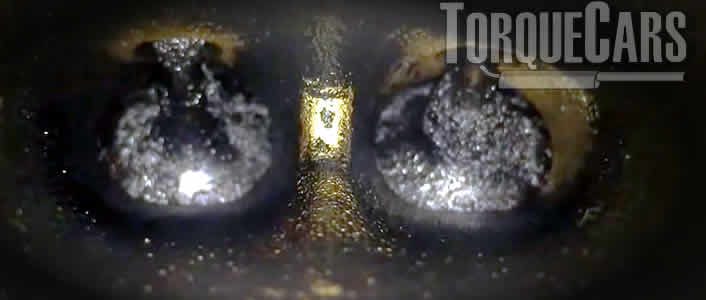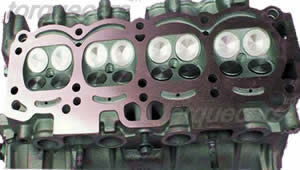Tuning the Removing carbon build up.
"How to remove carbon build up on intakes"
Why does this happen on direct injection engines?
It happens when an engine is cold and burning inefficiently or when it is shut off. The oil and particles in the engine are, for reasons of pollution and emissions control dumped into the intake where they are burned in the engine.
These particles attach to the intake valves and without any fuel flowing over them they are left to harden and build up.
Before direct injection the fuel was added as the air met the valves, and this fuel would effectively clean the valves.

VAG group engines and BMW engines seem to be the worst for this problem, and GM and Ford are significantly better.
Large capacity engines are much worse than smaller turbo units.
Newer engines that have direct injection have less of a problem with carbon build up but unless fuel is sprayed on the intake valves the issue is still present.
Why do we use direct injection then if it's such a problem?
It allows an engine to run at a much higher compression ratio, which is good for efficiency and power.
By spraying the fuel into the compressed cylinders air charge at the last minute there is no risk of detonation or premature ignition.
Direct injection fuel systems need to run at a much higher compression ratio.
How to remove the carbon build up.
DIY route
Using a spray cleaner, not a perfect result but this measurably improves the carbon issue and with repeated applications can help remove the carbon.
Here are some generic notes.
Cold engines will often divert the intake path along a different route into the cylinder so using the spray when it is cold will help improve cold starting issues or bad running caused by carbon build up.
Do not spray cleaner on the air flow sensor, most products advise you to spray between the air sensor and the engine block.

Spraying into a hot engine will pretty much bypass the carbon buildup affecting the cold engine but it will still help.
Allow the mixture to soak into the carbon and eat it away. Most people expect a 10 minute application to work and then take the car on a long drive.
For most products you should spray it in short bursts and lowish RPM, then turn off the engine and leave for at least 1 hour, then reapply and repeat.
After this take the car for a long run to clear out all the crud removed in this process.
Use a DIY spray application every few weeks to get ahead of the carbon build up, and then apply it regularly.
For some this will mean annual applications, for others it may be more or less frequent.

Where to spray.
The easiest route is usually to remove the air filter and spray into the intake stream, but we note that most products do not recommend spraying on the air flow sensor.
If a car has a turbo and intercooler then this spray will go through all those components and may just condense out and sit in the intake pipes. A higher RPM application can help mitigate this risk but ideally you should spray as near to the engine head as you can.
Removing a line or loosening the air flow housing will help get you nearer to where you want this spray to go.
As each engine is different it is hard to make one recommendation, but follow the directions from the manufacturer and for your specific engine.
A word of caution, if you get too much fluid in the cylinder you will end up causing Hydrolock (hydrostatic lock) which could bend your piston and ruin your engine. So if the engine stalls STOP SPRAYING, this is why we recommend short bursts of cleaner, and doing this over a period of time so it soaks in and gets working.
Professional route
Garages will take off the intake and spray abrasive particles into the engine.
We've heard of Walnut blasting where fragments of walnut hit the carbon and shave it off. The Walnut is soft enough to not damage any metal engine components.
There are also chemical particles that will remove the carbon, but completely dissolve in a carefully formulated solution.
There are also professional liquid sprays that go into the intake under carefully controlled pressurised delivery, and this can be very effective at removing carbon.
I had a local garage carry out a BG intake clean and it made a significant difference to my engines response and power.
What about sand blasting?
NO, certainly not on a head bolted to an engine, the particles left in the engine will exacerbate wear on all metal components it comes into contact with.
When a head is removed a complete tear down and clean can be performed, if you are doing this you may as well get the head flowed and ported.
How to prevent carbon build up
Newer engine designs now spray a little fuel on the intake, usually when an engine is cold, most at need of the cleaning effect and also requiring a richer fuel mix to warm up.
New engine designs also warm up more quickly, and this helps to mitigate the carbon build up issue.
Spraying fuel or methanol at the intake can help clean the valves, but this can cause ignition problems, premature ignition or detonation if not properly controlled and setup.
Oil catch cans have been suggested as effective, but we've not seen any evidence that these help reduce carbon build up.
Will injector cleaners remove the carbon build up.
In short, no! It is not sprayed into the intake so it will never contact the carbon you want to remove.
HOWEVER it will clean the injectors and internal engine components allowing the engine to run more efficiently and a clean burning efficient engine has less carbon deposits to worry about that a sooty dirty one.
If you liked this page please share it with your friends, drop a link to it in your favourite forum or use the bookmarking options to save it to your social media profile.
Check out TorqueCars new YouTube channel, and see their awesome new content...
Feedback
Please use our forums if you wish to ask a tuning question, and please note we do not sell parts or services, we are just an online magazine.
Help us improve, leave a suggestion or tip
